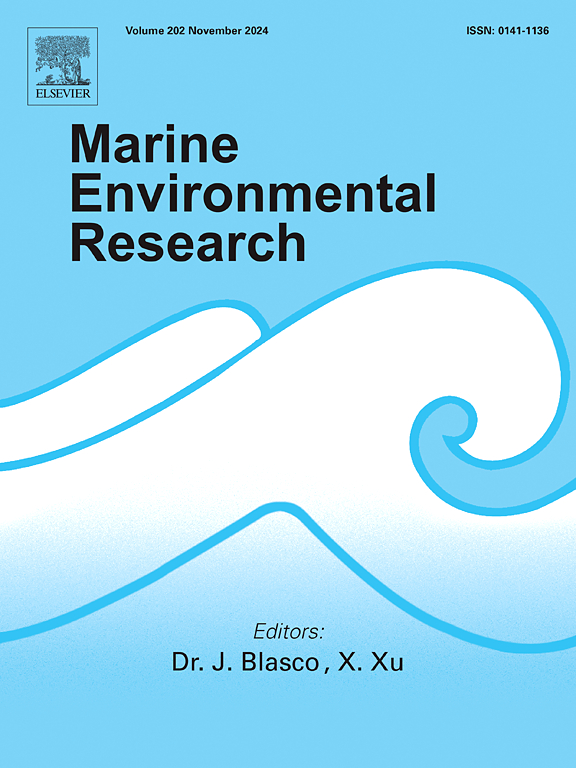Synoptic view of an unprecedented red tide in autumn/winter in the Bohai Sea, China, triggered by extreme rainfall events
IF 3.2
3区 环境科学与生态学
Q2 ENVIRONMENTAL SCIENCES
引用次数: 0
Abstract
In the context of global climate change, the incidence of atypical red tide events has increased. The Bohai Sea, characterized by a temperate monsoon climate, typically experiences red tide during the summer, with infrequent occurrences during the autumn and winter. Nevertheless, an extensive red tide manifested in the Bohai Sea during the autumn and winter of 2021. Its spatial and temporal distribution characteristics, along with the underlying driving mechanism, warrant further investigation. This study employs multi-source, high-resolution satellite data to delineate the spatiotemporal evolution of this unprecedented red tide. The driving mechanism was analyzed using the sea surface temperature (SST), photosynthetically active radiation (PAR), sea surface salinity (SSS), and riverine nutrients data. Multi-satellite data indicate that the red tide was marked by its extensive spatial distribution and prolonged duration. It was first detected on October 12 and persisted until November 27, covering a daily maximum and minimum area of 3287.46 km2 and 9 km2, respectively. The red tide encompassed three sub processes, including the red tide process in the southern part of Bohai Bay, the red tide process in the Yellow River estuary, and the red tide process in the Laizhou Bay and the south of Bohai Strait, with a cumulative red tide distribution area exceeding 35,000 km2. The driven mechanism analysis suggests that the red tide might be correlated with the elevated riverine nutrient loads, a consequence of the most severe autumn flood of the Yellow River since the 1940s, caused by extreme rainfall events. Historical data analysis indicates that another winter red tide in 2007 within the Bohai Sea was also caused by an atypical meteorological event. The results indicate that in addition to the atypical meteorological event itself, its eco-hazard risk, is also worth studying in the context of global climate change.
极端降雨事件引发的渤海秋冬罕见赤潮天气图。
在全球气候变化的背景下,非典型赤潮事件的发生率有所增加。渤海属温带季风气候,赤潮主要发生在夏季,秋季和冬季很少发生。然而,2021年秋冬渤海海域出现大面积赤潮。其时空分布特征及其背后的驱动机制值得进一步研究。本研究采用多源、高分辨率卫星数据来描绘这一前所未有的赤潮的时空演变。利用海表温度(SST)、光合有效辐射(PAR)、海表盐度(SSS)和河流营养物资料分析了其驱动机制。多卫星资料表明,赤潮具有空间分布广、持续时间长等特点。10月12日首次探测到,持续至11月27日,日最大覆盖面积为3287.46 km2,日最小覆盖面积为9 km2。赤潮包括渤海湾南部的赤潮过程、黄河口的赤潮过程和莱州湾及渤海海峡南部的赤潮过程三个子过程,累计赤潮分布面积超过35000 km2。赤潮的驱动机制分析表明,赤潮可能与极端降雨事件导致的黄河自20世纪40年代以来最严重的秋季洪水导致的河流养分负荷升高有关。历史资料分析表明,2007年渤海海域的另一次冬季赤潮也是由一次非典型气象事件引起的。结果表明,除了非典型气象事件本身,其生态灾害风险也值得在全球气候变化背景下进行研究。
本文章由计算机程序翻译,如有差异,请以英文原文为准。
求助全文
约1分钟内获得全文
求助全文
来源期刊

Marine environmental research
环境科学-毒理学
CiteScore
5.90
自引率
3.00%
发文量
217
审稿时长
46 days
期刊介绍:
Marine Environmental Research publishes original research papers on chemical, physical, and biological interactions in the oceans and coastal waters. The journal serves as a forum for new information on biology, chemistry, and toxicology and syntheses that advance understanding of marine environmental processes.
Submission of multidisciplinary studies is encouraged. Studies that utilize experimental approaches to clarify the roles of anthropogenic and natural causes of changes in marine ecosystems are especially welcome, as are those studies that represent new developments of a theoretical or conceptual aspect of marine science. All papers published in this journal are reviewed by qualified peers prior to acceptance and publication. Examples of topics considered to be appropriate for the journal include, but are not limited to, the following:
– The extent, persistence, and consequences of change and the recovery from such change in natural marine systems
– The biochemical, physiological, and ecological consequences of contaminants to marine organisms and ecosystems
– The biogeochemistry of naturally occurring and anthropogenic substances
– Models that describe and predict the above processes
– Monitoring studies, to the extent that their results provide new information on functional processes
– Methodological papers describing improved quantitative techniques for the marine sciences.
 求助内容:
求助内容: 应助结果提醒方式:
应助结果提醒方式:


